 |
|

|
 |
TABLE of CONTENTS
 |
MnDOT improves safety on Hwy 12 in west metro |
This video shows the safety improvements made on Hwy 12 after several fatal crashes along the west metro corridor. Video produced by Joel Wenz, Video Services |
|
 |
|

|
 |
TABLE of CONTENTS
 |
Statewide Freight System Plan addresses challenges, strategies to support state’s economy |
By Sue Roe

Each freight mode plays a critical role in moving goods efficiently in Minnesota. Rail is used to move 25 percent of goods, by weight, in, out, and across the state. For more information about the freight transportation system, check out the statewide freight system plan. Photo by David Gonzalez |
The Office of Freight and Commercial Vehicle Operations released the 2016 Statewide Freight System Plan, which guides MnDOT and its partners in preserving and improving the state’s freight transportation system.
The freight plan describes the state’s current freight system and its role in Minnesota’s economy, current and emerging trends, system performance, and current and future issues and needs. The 2016 plan is one of MnDOT’s family of plans that support the Statewide Multimodal Transportation Plan and the Minnesota GO 50-year for transportation in the state.
“Our freight transportation system allows Minnesota industries and businesses to move their goods and products to market, both within and outside Minnesota, including internationally,” said Commissioner Charlie Zelle. “The freight system also serves our communities and Minnesota consumers; it needs to be reliable, safe and efficient.”
Freight tonnage is expected to grow significantly by 2040, demanding improvements in the condition and capacity of freight infrastructure, including roads and bridges, rail lines and ports, according to Bill Gardner, OFCVO director.
“From the beginning, the public-private advisory committee that guided the development of the plan made clear that its objective was a realistic action plan,” he said. “The plan’s action agenda outlines the next steps that MnDOT and its freight industry partners can take to keep pace with the expected growth.”
The action agenda addresses challenges and strategies that will improve performance for highways, rail, waterways and air. The highest priorities for future action are system reliability, safety, congestion, bridge and pavement condition, and economic development.
The Minnesota Freight Advisory Committee was instrumental in helping MnDOT develop the plan and will oversee and help guide its implementation in the future.
“An efficient and effective freight transportation system will help us maintain our economic competitiveness in the national and global marketplace,” said John Tompkins, project manager.
The plan and a video explaining the plan development are online at www.mndot.gov/planning/freightplan/index.html. |
 |
|

|
 |
TABLE of CONTENTS
 |
WIG 2.0 teams share lessons learned at first report out |
|
By Judy Jacobs
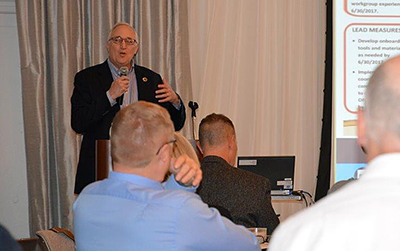
Bill Gardner, Office of Freight and Commercial Vehicle Operations director, told participants at the WIG 2.0 report out that it's important to "pick a good sub-WIG that matters to employees and just go with it." Photo by Judy Jacobs |
More than 100 managers, supervisors, district engineers, office directors, senior leadership and 4DX coaches participated in the first WIG 2.0 report out Nov. 22. Each work area shared their team’s priority, focus and goal areas, sub-WIGs, and scoreboards. In addition, teams reported on how they are tracking commitments, what’s going well, where they're getting stuck, what might be done differently and lessons learned.
Team insights and comments
Joy Penney, technology investment management director, Corporate Services Division, said, “Be prepared to spend the time you need to shape your goals. It’s also important to look at where we started, where we are going and see the progress we’ve already made. We’re moving ahead. As a team we’re stronger and are doing really good work.”
“Pick a good project that matters to employees and just go with it,” said Bill Gardner, Office of Freight and Commercial Vehicle Operations director.
Ted Schoenecker, deputy state aid engineer, State Aid for Local Transportation Division, said, “Momentum is critical. Weekly meetings mean we’re working to move the needle forward. It’s important to keep that energy going.”
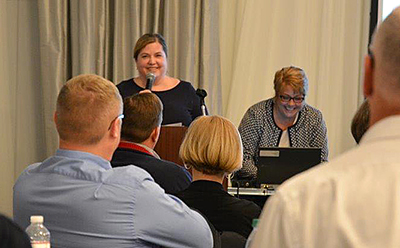
Jennifer W. Witt, 4DX coach for the Chief Counsel's Office, presented her team's summary at the recent report out, while AnneMarie Burgess, WIG 2.0 coaching program manager, assists. Photo by Judy Jacobs |
Kim Collins, Office of Civil Rights director and champion for the federal disadvantaged business enterprise goal area, said, “The office sub-WIG has been effective for us because we knew we would be a resource for many other offices. We welcome the opportunity to work with offices and districts to help advance WIG 2.0.”
“We’re seeing outcomes already,” said Jeff Vlaminck, district engineer for District 6. “Even something as simple as ordering lunch can be used as an opportunity to advance equity by looking for diverse vendors.”
Scott McBride, Metro District engineer and champion for the external customer engagement focus area, noted a comment from one employee who said he realized that by doing his job more efficiently it directly makes the public more efficient in their daily lives.
That thought was echoed by Deb Anderson, District 8 training and development specialist, who serves as a District 8 coach. “Our employees are working to improve our operations and they realize what they are doing has a direct benefit to the public,” said Anderson. “I think as we see more successes we’ll see more employees engaged.”
“A great side benefit is we see first and foremost our teams each have a better understanding of what the other employees within the office are doing to improve customer engagement and advance equity,” said Lynn Clarkowski, Office of Environmental Stewardship director.
Steve Lund, state maintenance engineer and Office of Maintenance director said, “I’m excited to see the level of engagement in WIG 2.0. Events like the listening sessions were better because employees had more awareness.”
As of Nov. 29, there are 587 teams across MnDOT engaged in WIG 2.0.
“We’ve heard today about employees coming together, tackling challenges, and connecting more in the process,” said Tracy Hatch, deputy commissioner, chief operating officer and chief financial officer. “Stay the course. Having 5,000 employees complete one commitment a week will move the needle. I guarantee you will see changes a year from now. Great job, everyone!”
|
Check out the internal survey response progress tracker on iHub to see how many of your coworkers have completed the WIG 2.0 internal survey. If you haven’t completed any surveys yet on your internal customer interactions, please take a minute to do so now—time is running out! The deadline for survey responses is Dec. 31. |
|
 |
|

|
 |
TABLE of CONTENTS
 |
Training program for managers, supervisors starts in January |
|
Courses that meet the criteria for the requirement are considered eligible for this program. The criteria include content related to:
• HR Policies
• Diversity and Inclusion
• Keeping the Workforce Safe
• Laws and Regulations
• Finance/Budget/Payroll
• Ethics
• Competency Enhancement: Teamwork, Visioning, Strategic Planning, Coaching, Mentoring, Empowering, Conflict Management, Negotiation, Decision making, Integrity, Credibility, Character, Accountability, Responsibility, Communication, Planning the Workforce, Delegation, Time Management, Innovation, Coaching, Motivation, Process and Procedure Management, Customer Focus. |
MnDOT recognizes that the strength of its leadership is based on the knowledge and behaviors of all of its employees. This includes managers and supervisors who require a set of competencies and skills that keep them motivated and challenged to stay abreast of changing techniques, requirements and growth in the transportation industry.
In response to an agency-wide control environment assessment, and the expressed concern from the executive team, MnDOT has chosen to implement a sustainable required statewide Manager Supervisor Training Program that will be launched in January 2017. This program will provide a platform of continuous learning and competency enhancement for managers and supervisors.
What is the requirement?
Beginning in January, all managers and supervisors will be required to satisfy a four-course training requirement to keep their core competencies and skills up to date. The first program year will be 18 months, starting January 2017 and continuing through June 2018. The requirement will continue every fiscal year after the first program year. What that means is every manager and supervisor will take four eligible training courses within that time frame. They will be able to choose from a list of eligible courses to meet their development needs and fit their schedule. This requirement is intended to give credit for the training attended and provide a variety of training to meet individual development needs.
How will the program work?
Starting in January, managers and supervisors will be able to attend a variety of ‘eligible’ courses offered by MnDOT offices and districts. These courses will be offered in a variety of formats including classroom, on-line through Skype business sessions (Lync), e-learning, or web-based training. Managers and supervisors can choose which courses they want to attend and sign up for them according to their schedule.
The Manager Supervisor Training website on iHUB provides specific information about the program, and a Manager Supervisor Training calendar is available on Outlook to view upcoming classes. These resources will assist managers and supervisors in scheduling.
For detailed information about the program, available courses, FAQs, and contact information refer to the Manager Supervisor Training Program iHub site. A video information session is also available on that website with complete information on the four-course requirement and how the program works. The Manager Supervisor Training calendar can be accessed on Outlook. The address is *DOT_Manager Supervisor Training. Questions can be directed to the Manager Supervisor Training email address.
|
 |
|

|
 |
TABLE of CONTENTS
 |
Enrollment for Leadership Development Program opens Dec. 12 |
By Shawn Meade, Leadership Development Program
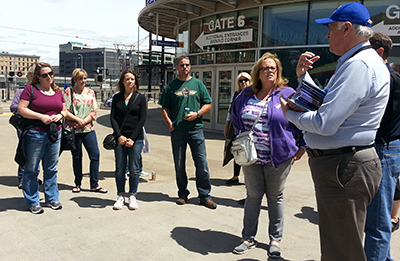
Joe Scala (right), Hennepin County, talks to a group from the Leadership Development Program, about the multi-modal experience June 2 at Target Field Station. From the left are Keri Lewis, Metro District; Sara Pianalto, Central Office; Angie Fonkert, District 3; Joseph Groshens, Metro District; Cindy Pieck, Central Office; and Kelly Pearson, Metro Disrict. Photo by Amanda Klawiter |
Employees’ motivation and willingness to improve their competencies allows MnDOT to remain adaptable and productive, and ultimately provides quality service to its customers. This can easily be achieved through the Leadership Development Program, with little to no expense, other than one’s time and attention.
“Employees are realizing the benefits of participating in the program and using its resources to assist them with their development,” said Carol Hennekens, Leadership Development Program manager. “The 2016-2017 program year, which started in September, is offering many new learning opportunities and additional resources which will support new as well as past participants who want to enroll again.”
Open to all employees, the program is individually customized and flexible to meet participants’ development goals. It can be structured, informal, rigorous, ongoing and flexible all at the same time. This unique program requires participants to create their own development goals and set their own development schedule to fit their busy work schedule.
Suzi Klawiter, Principal Customer Service Representative, has participated in program activities multiple times.
“Participating in the LDP has been a great experience for me. My skills, knowledge and abilities have been enhanced and increased on how I interact with internal and external customers. I utilize my gained knowledge and skills in all tasks and roles throughout my work day. This program has not only benefited me, but also those whom I provide customer service. The LDP is a flexible development program. I enjoy the ability of self-directed learning development. Throughout the three LDPs in which I have participated, I created a self-directed learning plan which fits my goals, schedule and learning style. I will continue to participate in future LDPs and encourage others to participate at least one time.”
The 2016-2017 Leadership Development Program is structured with two groups starting at different times during the program year. Group 8 will start March 1, 2017, while Group 7 started Sept. 1, 2016.
To learn more about the Leadership Development Program, and how to enroll in Group 8, visit the LDP website. You are also invited to attend a Skype information session hosted and facilitated by the LDP team. See the dates below. To register for an info session, send an email with the session date to shawn.meade@state.mn.us.
Leadership Development Program – optional Skype information sessions
- Friday, Dec. 2 – 9 to 9:30 a.m.
- Monday, Dec. 5 – 10 to 10:30 a.m.
- Wednesday, Dec. 7 – 2 to 2:30 p.m.
- Tuesday, Dec. 13 – 3:30 to 4:00 p.m.
The LDP Team is available to answer questions. Contact Carol Hennekens, Shawn Meade, or Amanda Klawiter. |
 |
|

|
 |
TABLE of CONTENTS
 |
Need IT support? Think twice before dialing |
By Greg Ruhland
In December, calls to the IT Service Desk (651-355-0200 in Central Office) will be limited to time-sensitive incidents – conference room emergencies, failed equipment, computer viruses and software issues.
All other IT requests should be submitted from any MnDOT desktop.
Why is IT Service Desk limiting the calls it accepts?
In recent months, general questions and minor incidents have consumed a rising share of IT Service Desk resources. At the same time, an uptick in call volume has reinforced the need to efficiently manage these incidents. To maintain high quality service, MnDOT customers should be using self-service options whenever possible to make non-urgent IT requests.
NOTE: Password resets should be directed to https://passwordreset.dot.state.mn.us/, but you will need to register first.
How should staff submit an IT request from the desktop?
Look for the gold “surfer” icon on a MnDOT desktop computer or send an email to itservicedesk.dot@state.mn.us. If a MnDOT desktop isn’t available, visit https://connect.mn.gov/sites/mndot-mnit/itstorefront/ to submit your request.
Entering an IT service request
1. Under Get Help, look for this blue button:
2.
Then under Popular Requests, select the red IT Service Request option.
3.
Enter the request and click Submit when finished.
If you have further questions, contact Rudy Mohamed, Technology Investment Management office. |
 |
|

|
 |
TABLE of CONTENTS
 |
Technicians climb more than 300 feet to maintain radio towers |
Tower maintenance technicians from the Office of Electronic Communications keep radio towers around Minnesota running smoothly. This video explains the importance of the towers and the work these technicians do. Video produced by Rich Kemp |
|
 |
|

|
 |
TABLE of CONTENTS
 |
Two employees honored at statewide TZD conference |
By Sue Roe
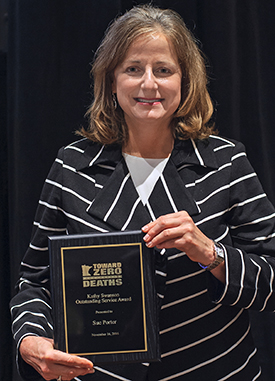
Sue Porter received the Kathy Swanson Outstanding Service Award at the TZD statewide conference in Duluth Nov. 16 for her leadership in the effort to improve traffic safety. Photo by David Gonzalez |
Two MnDOT employees were among those honored at the statewide Toward Zero Deaths conference Nov. 16-17 in Duluth. Nearly 1,000 traffic safety advocates and stakeholders attended the annual conference to share best practices and learn new approaches to reducing the number of traffic fatalities in the areas of education, engineering, enforcement, and emergency medical and trauma services.
Sue Porter, former TZD chair and director of the Office of Traffic, Safety and Technology, and now manager of Transportation System Management and Operations, received TZD’s Kathy Swanson Outstanding Service Award. The award recognizes individuals who have shown exceptional leadership in efforts to improve traffic safety in the state, build partnerships and mentor others in the field.
Porter was the state traffic engineer from 2008 to 2015. She was a champion for safety within MnDOT and with local, state and national partners. During her time at OTST, the office was honored for designing, testing and helping deploy life-saving rural intersection conflict warning systems throughout the state, while leading the national effort throughout rural America.
During her time as TZD co-chair, the TZD initiative grew from being in only one region to encompassing the entire state. She also advocated for one-half of Minnesota’s federal highway improvement funds to be shared with local governments to improve county roads.
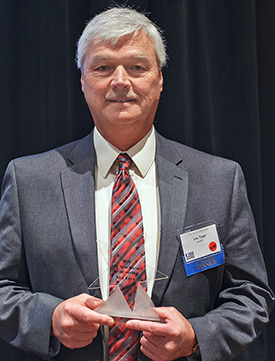
Lou Tasa received the Engineering Star Award at the TZD statewide conference in Duluth Nov. 16 for his work in the effort to improve traffic safety. Photo by David Gonzalez |
Lou Tasa, District 2 assistant district engineer in the State Aid office, received the Engineering Star Award. Tasa is a founding member of the Northwest Minnesota TZD leadership team. He built relationships with county engineers in the district and helped bring all 11 county engineers on board with TZD. He encouraged county engineers to submit safety projects for the Highway Safety Improvement Program and the region received approval for more than $7 million of projects between 2013 and 2016.
Tasa also works with county board and local township organizations to adopt TZD and the 4E approach when considering improvements to county highways.
Other award winners
Eight other individuals and organizations were honored at the conference for their leadership and commitment to improving traffic safety throughout the state. They are:
- Distinguished Public Leadership Award - Chief Gary Kroells, West Hennepin Public Safety Department
- Emergency Medical and Trauma Services Star Award - Matt Jakubik, North Memorial Air Care
- Traffic Safety Innovation Award - Motorcycle Dial-A-Ride
- Child Passenger Safety Star Award - Laura Owen, Duluth Fire Department
- Education Star Award - Isanti Police Officer Adam Gau
- Judicial/Court System Star Award - Michelle Zehnder Fischer, Nicollet County Attorney
- Enforcement Star Award - Blue Earth County Deputy Sheriff Tom Coulter
- Media Star Award - Dodge County Independent Newspaper
Featured speakers
Featured speaker for the conference was Rodney Wambeam, senior research scientist at the University of Wyoming, who talked about research on millennials and how they contrast with previous generations. He discussed how these differences can inform traffic safety and prevention efforts.
Speaker for the second day was Jana Price, senior human performance investigator at the National Transportation Safety Board. Reducing fatigue-related crashes is on the NTSB’s “Most Wanted List” of transportation safety improvements. She talked about some high-profile crash investigations with common risk factors for sleep-related crashes.
The TZD program is an interdisciplinary partnership with the state departments of Health, Transportation and Public Safety. This collaboration began 13 years ago and has worked to reduce roadway fatalities by more than 60 percent.
Next year’s TZD statewide conference will be Oct. 26-27 in St. Paul.
Learn more about TZD at www.minnesotatzd.org. |
 |
|

|
 |
TABLE of CONTENTS
 |
MnDOT employees contribute $40,000 to 2016 Combined Charities campaign |
By Judy Jacobs

The Combined Charities Campaign is an opportunity for Minnesota state employees to donate to charities of their choice. |
MnDOT employees donated nearly $40,000 to the 2016 Combined Charities giving campaign. To date, campaign pledges from all state agencies total $784,824, with 1,980 state employees pledging. A final report will be issued Dec. 5.
“This year we had 101 MnDOT employees donate almost $40,000,” said James Pontius, Office of Human Resources and campaign coordinator for Central Office. “This includes annual payroll pledges, one-time gifts and donations from events held throughout the state.”
State employee donations help support more than 1,400 charities representing a wide variety of health, education, environmental, arts and social service programs (e.g., food shelves, women's shelters, health initiatives and youth programs).
The annual Combined Charities campaign, established in statute, has raised more than $20 million for Minnesota charities. During the 2015 campaign, employees pledged over $800,000 for Minnesota charities.
Donations to Combined Charities can be made year-round. To learn more about the campaign and how to pledge a donation, visit the Combined Charities' website: www.mn.gov/mmb/combined-charities/employee-giving/. |
 |
|
| |
|



